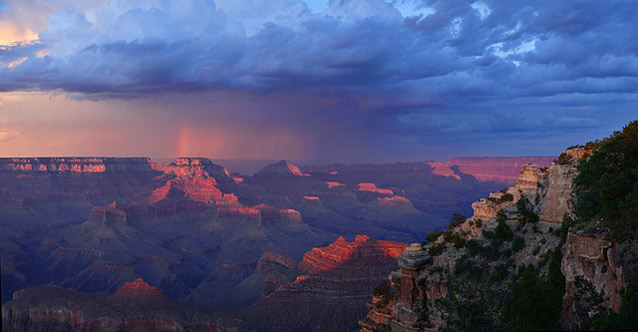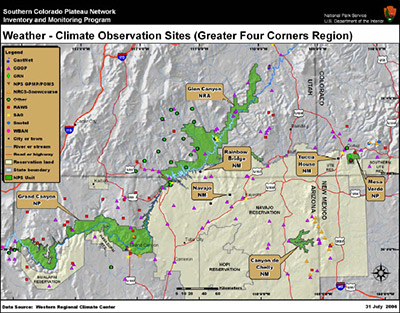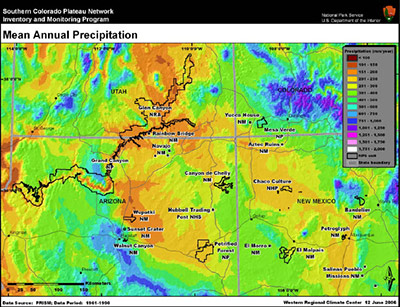Importance
In 1999, the National Park Service initiated a system-wide program to improve scientific knowledge about natural resources in park ecosystems. This program was called the Natural Resource Challenge. One component of the program was to conduct basic inventories of 12 important resources in parks as a foundation for planning long-term monitoring of natural resource “vital signs.” Climate—weather patterns over time—was identified as one of the 12 important resources. Climate affects the movement of energy and matter through ecosystems, and drives many environmental processes. Park managers use climate data to inform native and invasive species management. Climate data also provide context to help interpret patterns in other vital signs.
An inventory of climate information for the parks of the Southern Colorado Plateau Network (SCPN) of the National Park Service was conducted and the results published in the technical report, Weather and Climate Inventory, National Park Service, Southern Colorado Plateau Network (2006).

Michael Quinn / NPS
The Inventory
The climate inventory documented past and present climate monitoring efforts at SCPN parks, focusing largely on identifying weather and climate stations in and near SCPN parks. Metadata collected about these stations included their location and physical setting, as well as what types of observations were collected at each station, by whom, during what time period, and using what methods. SCPN found much of this information from The Western Regional Climate Center, as well as by interviewing NPS and other agency staff who maintain weather/climate stations.

Western Regional Climate Center
SCPN identified 55 weather and climate stations in SCPN parks during the inventory. Stations were part of several national-scale weather and climate station networks, including the National Weather Service Cooperative Observer Program (34 stations), the Remote Automated Weather station network (RAWS; 5 stations), the Surface Airways Observation Network (3 stations), the Climate Reference Network (1 station), and the Clean Air Status and Trends Network (3 stations). Mapping the location of all stations provided a way to look at their distribution across the region. SCPN parks in New Mexico and southwest Colorado benefited from a relatively dense distribution of weather/climate stations. In contrast, SCPN parks in northeastern Arizona and northwestern New Mexico were not as well-represented by weather/climate station data.
The inventory produced several useful end-products. Graphs and color images show long-term trends in temperature and precipitation for specific SCPN parks and for the network in general. Maps and tables describe the location of weather/climate stations by region. Appendices define climate-monitoring terms and principles, and offer guidance for the design of weather/climate-monitoring programs.

Western Regional Climate Center
Recommendations
The SCPN climate inventory provided some specific recommendations to support long-term monitoring of climate in parks. The authors recommended exploring potential partnerships with the RAWS network to get better weather/climate station coverage in northeastern Arizona and northwestern New Mexico. They identified a need for an additional station on the floor of the Grand Canyon, which could also help with flash-flood monitoring and in studying climate gradients between the canyon’s rim and floor. The authors also highlighted the importance of maintaining stations with long-term climate records because of the valuable information they provide about natural climate characteristics.
**********************************
Project report
Davey, C. A., K. T. Redmond, and D. B. Simeral. 2006. Weather and Climate Inventory, National Park Service, Southern Colorado Plateau Network. Natural Resource Technical Report NPS/SCPN/NRTR— 2006/007. National Park Service, Fort Collins, Colorado.
Prepared by Sonya Daw, Southern Colorado Plateau Network Inventory and Monitoring Program, 2014.
Last updated: March 14, 2022
